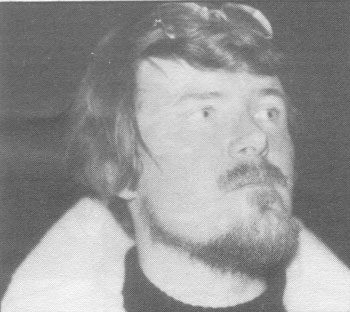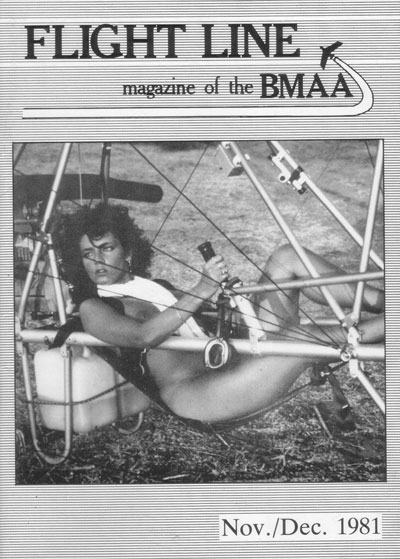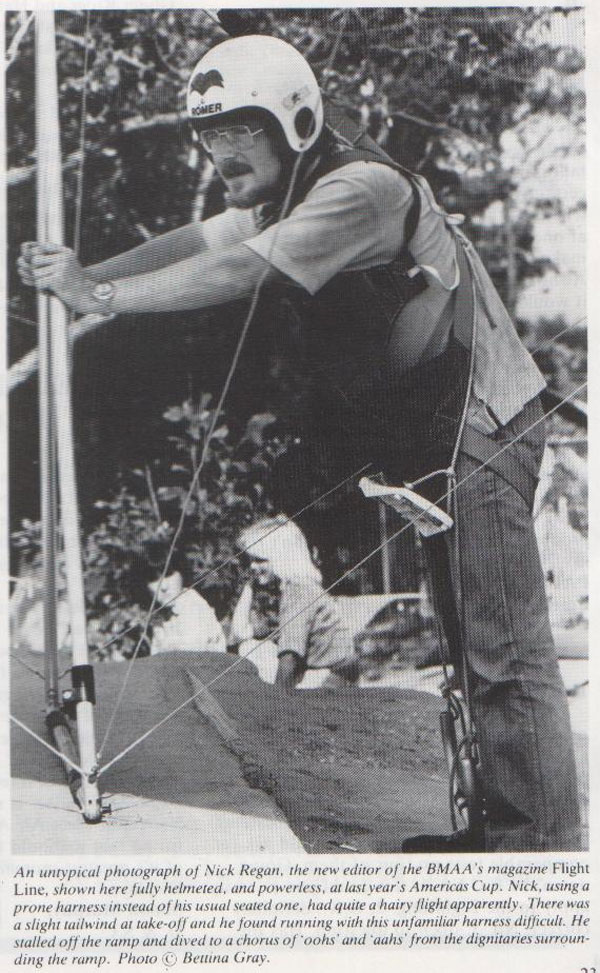 |
Nick Regan
 |
Nick 1981
Nick Regan is a name that is constantly being mention, amongst a hand full of early flyers in the UK during 1972. His perception on life and the rules he lived by are also the stuff of legends and therefore it certainly makes him eligible to be one of the very early characters during the birth of the British hang glider. I’ve spoken to him a few times via phone (2008), sadly he has let the computer age pass him bye, but I guess that’s the old Nick I will always remember and the years have not changed him. On each occasion I’ve tried to get him to send me an article, but I think it would be much easier to get him to fly a hang glider wearing a crash helmet.
During the summer of 1972 Nick and a friend designed their own hang glider, and built it during October of the same year. At the time Nick was in touch with Joe Faust in the USA, having read one of his early hang gliding magazines “Low and Slow”. However, they based their glider on the “Kilbo plans” drawn up by Dave Kilborne from the USA, which were distributed free in the “Low and Slow” magazine #6 in mid 1971.
In early November 1972 Nick finally flew his own designed flexwing hang glider at Farnham Park. A year later I wrote to Nick for advice and he sent me a great reply that I wish I could find and add to this article, sadly I think its long been mislaid.
He went on to become heavily involved in the formation of The BHGA and for a time was editor for the early ‘Wings’ magazine. Nick was always to be seen at official flying events and was also usually heavily involved in the marshalling and behind the scenes organisation.
During the early 80’s he had a spell editing the BMAA ‘Flight Line’magazine. On many occasions he’s told me that his greatest achievement was the cover photo of the Nov/Dec 1981 ‘Wings’ magazine, I wonder why?
Terry Aspinall
Click on photo to enlarge repeat to shrink
..
An article from Dave Tait taken from the #13 edition of the Wings magazine 1976
It's worth noting that Nick's A-Frame is not rounded at its bottom corners. This shows that both he and Geoff McBroom took a different path of ideas when building their gliders, while most of the other manufactures in the UK used a rounded corner to the A-Frame. This has a long story that helps work out who copied who. The story behind the rounded corner goes back to John Dickenson who in 1963 invented what we now call the modern hang glider in Grafton NSW Australia. When he was building the glider he used aluminium tube because at the time he was installing domestic television aerials, and because he did not know how to bend the tube he used a rounded frame from the top of an old bed stead. It has since been proven that it had no beneficial affect on the glider what so ever, in fact it's even been proven that it was actually weaker than what manufactures used later in the gliders development. On this web site you will see photos of all the manufactures using rounded corners, some right up to 1976 and world wide some up to 1978. This is just another example of how we copied the Dickenson Wing. However Nick is one of only two in the UK who did not use this method during the design and the building of his hang glider in 1972.
From Nick Regan his Design Cover
Sorry I spoke to soon
somebody has just sent me the only known photo of Nick wearing a helmet
Photo by Bettina Gray
All the material on this site is subject to copyright Much of this material may only be reproduced with the written permission of the copyright holder |



